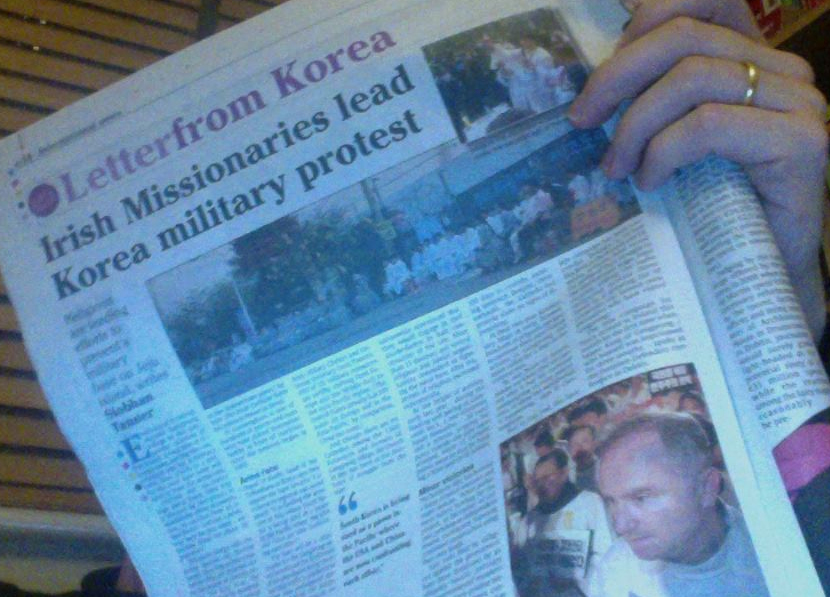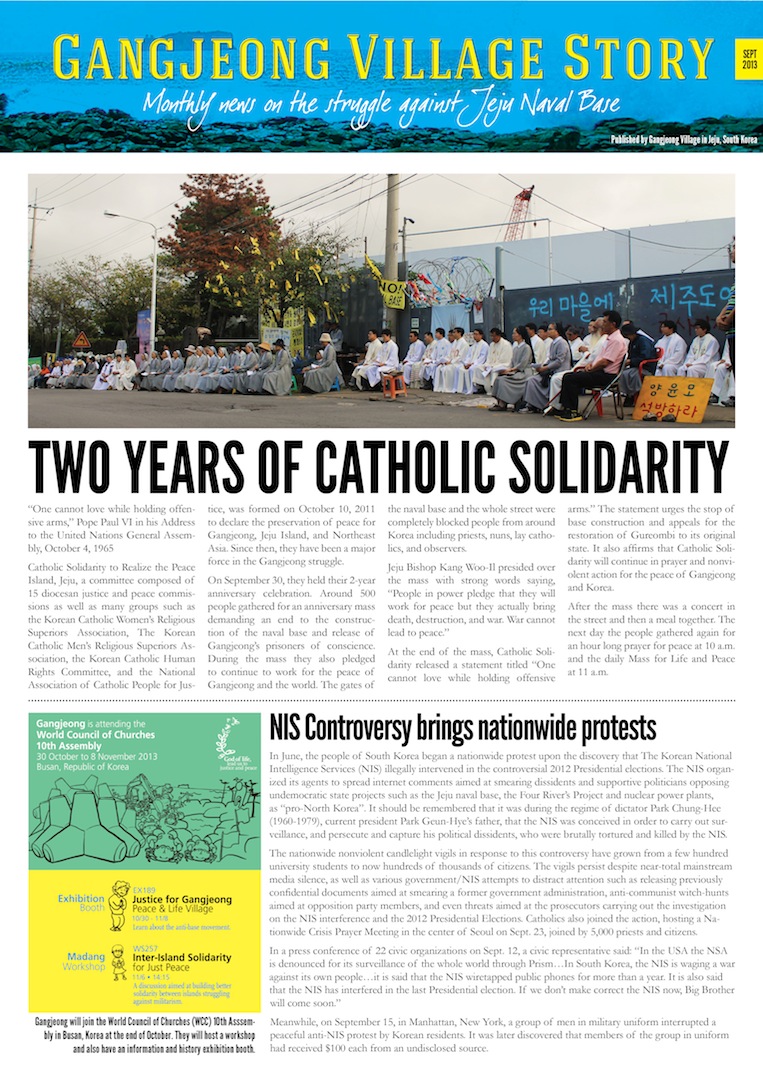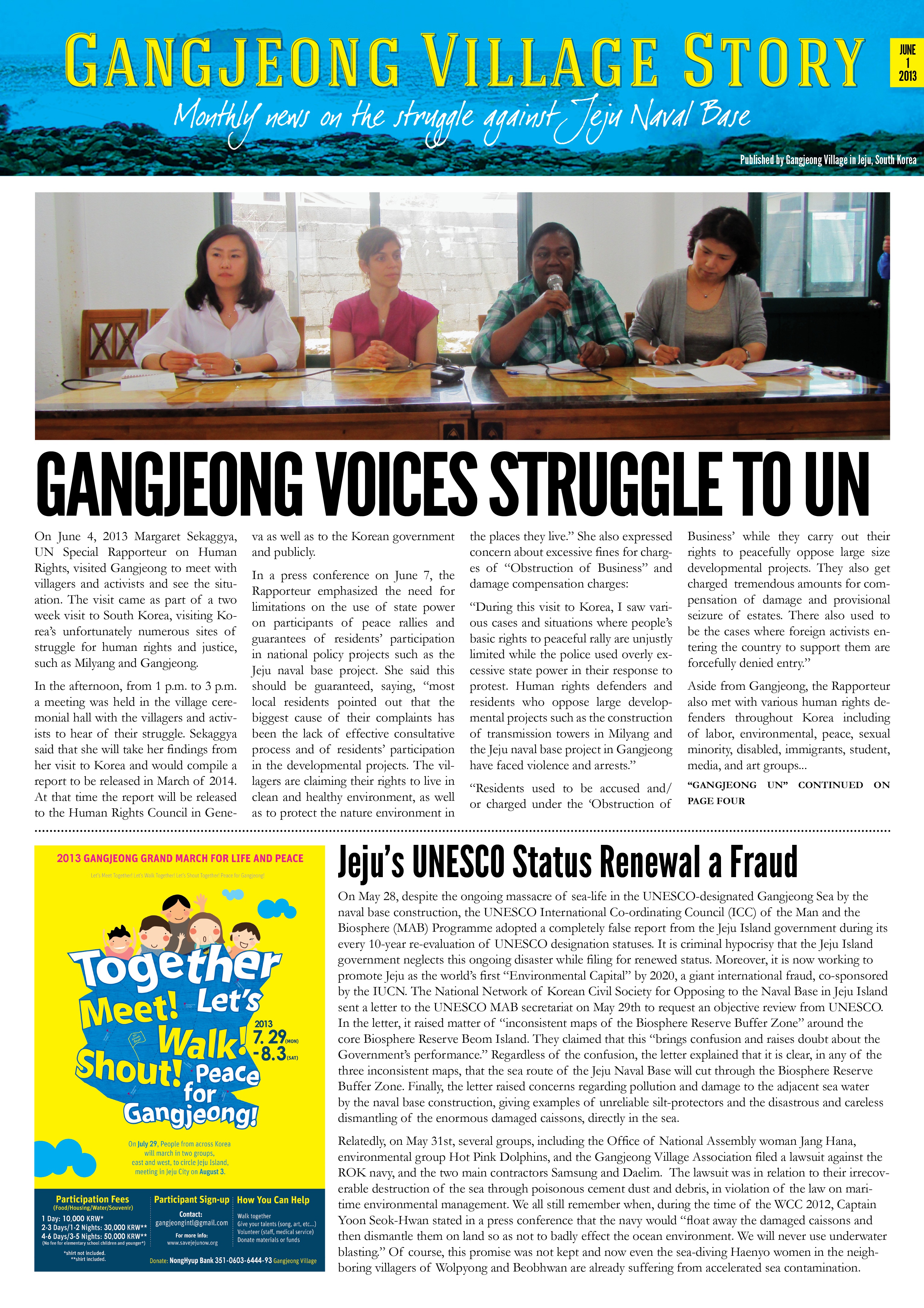In this month’s issue:
City of Berkeley passes Gangjeong Resolution, 2014 base budget issues, Love letter from Afghanistan, Milyang solidarity, Gangjeong Crochet Project, Solidarity from Germany, trial updates, and more!
Save Jeju Now
No War Base on the Island of Peace
Tag: Catholic
-
An Irish Catholic Joining Protest Opposing Base
Re-blogged from here: The Irish Catholic, 2013. Irish Missionaries lead Korea military protest (Fwd by John Whipple). Though it does not necessarily reflect Save Jeju Now’s own view, the re-blogged article is helpful to glance on the degree of international solidarity opposing the Jeju naval base project. The role of Catholics worldwide, especially Irish Catholic’s, represented by Fr. Pat Cunningham, is remarkable.
Regarding the number of the Catholics in the village, Paco Booyah, a member of the Village International Team writes: ‘There are several villagers who are Catholics. But not many. Also because of the Catholics’ brave and strong actions, there are several villagers who have considering becoming catholic. There are more protestants than Catholics among the villagers though. And actually a majority of the villagers are Buddhist. Many villagers also believe traditional Jeju shamanism.’
Irish Missionaries lead Korea military protestReligious are leading efforts to prevent a military base on Jeju island, writes Siobhan Tanner
Religious who gathered for the anniversary Mass on Jeju.
Every day at 11 o’clock outside Gangjeong village on the spectacular coastline of Jeju island, a long line of cement trucks, serving the construction site for a military naval base, grinds to a halt. For the next hour none will enter or leave the compound.
Outside the six-metre high metal fence, their way is blocked by two priests in windblown white vestments. One, on rotation from an island parish – and one, a Jesuit, sent here for this cause – are holding Mass for about 20 protesters.
When the liturgy ends, the group spreads out, holding hands. They sing protest songs before they are drowned out by the sound of starting engines. The hour is up. The trucks, flanked by hundreds of police, army and private security (up to 600-strong, reports one observer) break forcibly and easily through the human chain, arresting some and scattering others.
This is the daily show witnessed by Colomban missionary, Fr Pat Cunningham, who has become increasingly radical since coming to South Korea in 1992.
Deportation
He has been threatened with deportation for protesting a massive military naval base on the pristine Unesco-protected island of Jeju, 50 kilometres south of the Korean peninsula. More than 130,000 police and army personnel have been sent to supress the opposition since 2011. “Surveillance is so huge down there and anyone who criticises the base is ‘red-brushed’ and labelled a North-Korean sympathiser in the mainstream press,” he tells The Irish Catholic from his mission house in Seoul.
Fr Cunningham is one of hundreds of priests and nuns who have placed themselves bodily in front of machines since the protests began in 2007.
Arms race
Donal O’ Keefe, head of the Colombans in Korea says they oppose the base because it is a threat to regional and world peace. “It is fuelling the arms race in Asia where South Korea is being used as a pawn in the Pacific where the USA and China are now confronting each other.”
The base will be a catastrophe for the Gangjeong environment and the livelihoods of the population living there; warship traffic is predicted to drive nine endangered species, including the bottle-nosed dolphin, towards extinction.
Due to be finished by primary contractors Samsung in 2014, the base will be contracted by the US to house 7,000 marines and 20 warships, including aircraft carriers, nuclear submarines and destroyers armed with ballistic missiles which will patrol the East China Sea.
Koohan Paik, campaign director of a forum on Globalisation’s Asia-Pacific programme says Jeju is just one island in a growing constellation of geostrategic points that are being militarised as part of President Obama’s ‘Pacific Pivot’, a major initiative announced late in 2011 to counter a rising China. According to separate statements by then Secretary of State Hillary Clinton and Defense Secretary Leon Panetta, 60% of US military resources are swiftly shifting from Europe and the Middle East to the Asia-Pacific region. (The United States already has 219 bases on foreign soil in the Asia-Pacific; by comparison, China has none.)
And though there are no Catholics among the 1,500 fishermen and farmers of Gangjeong village, the Church in Jeju has been at the forefront of struggle from the start.
Hunger strike
When the governor of Jeju (since ousted) agreed to accept the naval base on the island province in 2007, local priests went on a hunger strike and their bishop, Peter Kang U-il, wrote an open letter to South Korea’s president urging a referendum on the plan.
The Jesuits too waded into the battle early, sending priests from the mainland – four of whom were imprisoned for sentences ranging from one month to three.
Then, two years ago, the Church in Korea made a bold political move when clergy nationwide announced that they would engage in civil disobedience to halt construction of the site. More than 15 dioceses and several religious and justice organisations committed to fighting the naval base. After this, arrests of religious increased exponentially.
At the height of activity early last year – during the blasting and paving of Gureombi Rock, a one-kilometre basalt formation – 20 nuns and a priests, praying for peace outside the gate were arrested, while 13 Catholic priests went on trial for holding a Mass and sit-in protest.
Minor victories
The battle for Jeju has become a litany of minor victories and major defeats. When parliament halted funding for the project, in December of last year, pending an independent review, contractors Samsung continued construction using their own funds.
Law suits filed by villagers against the government have been dismissed by an allegedly hostile judiciary and environmental monitors report that once-pristine water sources have been contaminated while dredging has started to kill the underwater coral.
Meanwhile, the penal crackdown on activists has increased.
Three months ago, Brother Park Do-Hyun and Dr Sang Kang-Ho, members of Save Our Seas, were arrested while monitoring the dredging of the sea-bed which was being done without environmental protection measures.
Both men have passed 100 days in custody, awaiting sentence. Despite, these setbacks, the Catholic-led protests show no signs of diminishing.
At their two-year anniversary Mass in early October, hundreds of religious pledged to continue their non-violent actions in Gangjeong and again called for a stop to the construction.
“In our heart of hearts, maybe we know that we cannot stop it but we continue campaigning to raise awareness, to show the world what is happening,” says Fr Cunningham.
And to this end, the Save Jeju campaign has been successful. Despite a virtual blackout in the Korean and US media, activists have raised the profile of their struggle to the international stage, most recently adding the name Hollywood director Oliver Stone to a growing list of celebrities and famous commentators who have visited Gangjeong.
The Jeju campaign for Peace arrived in Ireland this month for the first time when Mayor Kang of Gangjeong – who himself was imprisoned for three months – spoke at the Frontline Defenders conference in Dublin.
– See more at: http://www.irishcatholic.ie/article/irish-missionaries-lead-korea-military-protest#sthash.Osd7LLh3.dpuf
…………………………………..
-
UN Special Rapporteur on Human Rights Visits Gangjeong
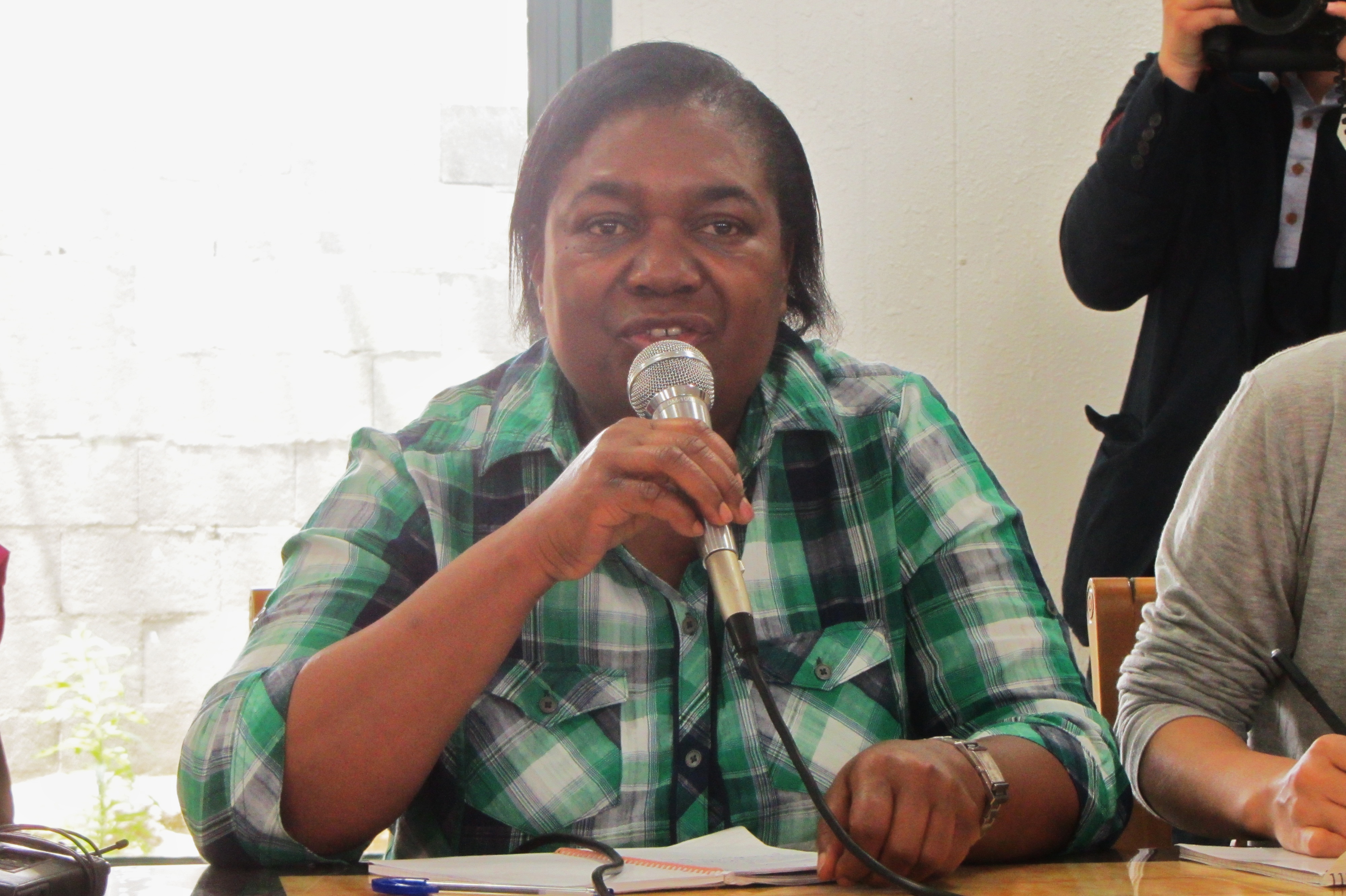
Margaret Sekaggya, UN Special Rapporteur on Human Rights, Introduces herself to Gangjeong residents. On June 4, 2013 Margaret Sekaggya, UN Special Rapporteur on Human Rights, visited Gangjeong to meet with villagers and activists and see the situation. The visit came as part of a two week visit to South Korea, visiting Korea’s unfortunately numerous sites of struggle for human rights and justice, such as Milyang and Gangjeong.
In the afternoon, from 1 p.m. to 3 p.m. a meeting was held in the village ceremonial hall with the villagers and activists to hear of their struggle. Sekaggya said that she will take her findings from her visit to Korea and would compile a report to be released in March of 2014. At that time the report will be released to the Human Rights Council in Geneva as well as to the Korean government and publicly.
Upon her arrival many reporters and broadcast news personnel were waiting but following a brief introduction were made to leave and the doors were shut, so that the villagers could speak in private without press intimidation.
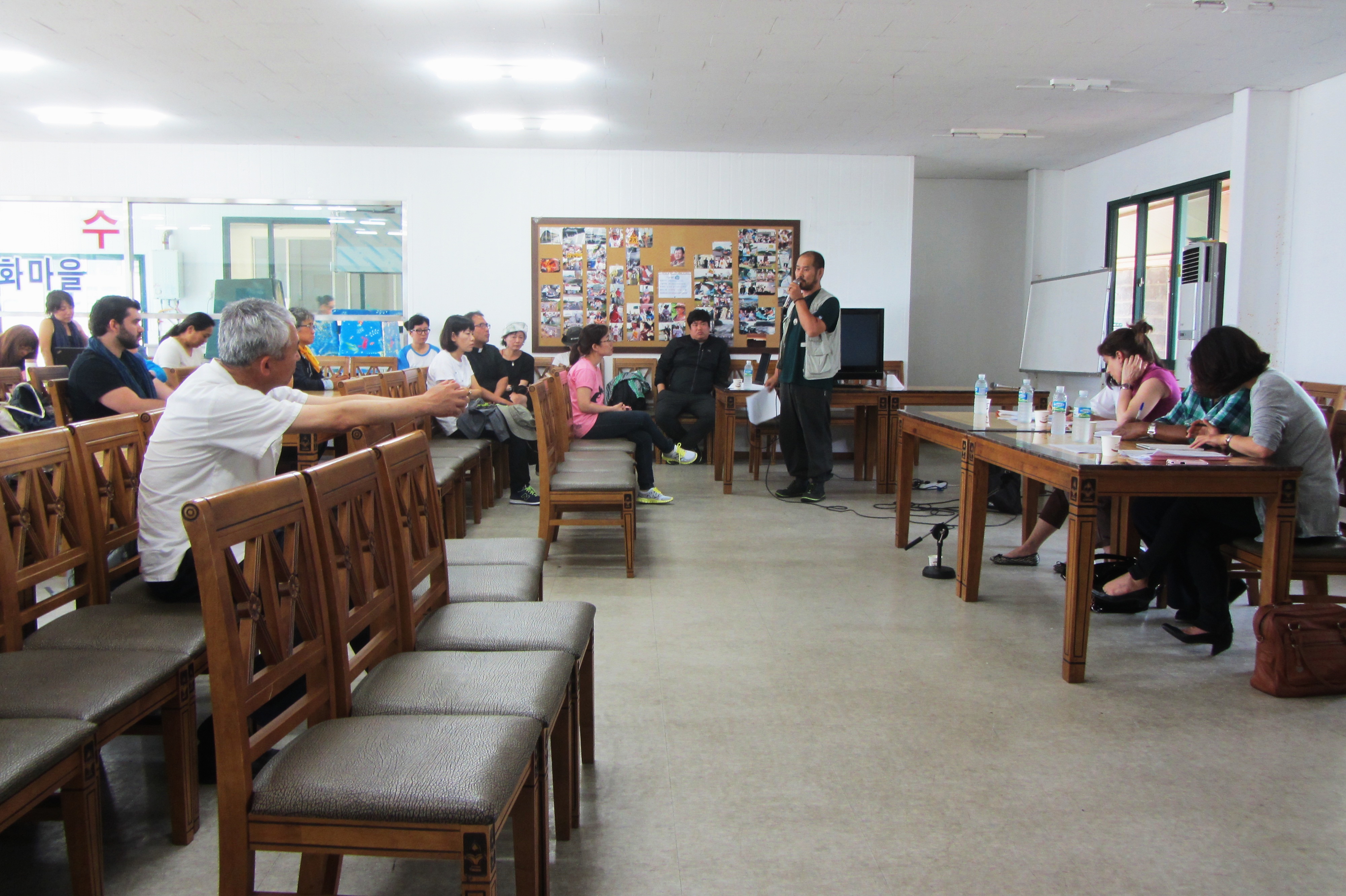
Village Anti-Base Committee Chairman, Goh Gwon-Il, begins the proceedings. The proceedings were emceed by Village Anti-Base Committee Chairman, Goh Gwon-Il who began giving a detailed overview of the history and facts of Gangjeong and the base project until now, such as the first fake vote and the second real vote where 94 percent of the 725 villagers in attendance voted against the base.
Descriptions of military, construction, and police harassment of villagers and activists followed. A video from 2011 of naval soldiers harassing and fighting with villagers was shown. Then a video of the 4-on-1 water assault on and beating of Dr. Song Kang-Ho by Coast Guard SSU Special Unite Divers in 2011. Next a video was shown of Villagers and activists attempted to climb a barge to talk to the workers and navy, and being beaten and pushed from the boat by workers and the navy.
Next videos were shown of the recent crackdown on the sit-in tents near the gate, including the near hanging on Mayor Kang by careless police and public workers, as well as the police pushing Villager Mi-Lyang off a 6 meter high ledge. Then Mi-Lyang, who is still in the hospital for recovery, came to give her testimony of the situation. It was clearly very difficult for her to speak of the recent traumatic event.

Villager Kim Mi-Lyang tells about her traumatic fall at the ends of the police. Then, Catholic Fr. Kim Sung-Hwan came to speak about and show videos of the oppression on the Catholics, including the near death of Father Mun in April of 2012 as well as the pushing over of Father Mun during communion destroying the sacraments, general police oppression and disruption of the daily catholic mass, including the outrageous use of pepper spray on those attending the mass.
Next, tangerine farmer and chairwoman of the Village Women’s Committee to Stop the Base, Jeong Young-Hee, came to talk about and show pictures and videos of further struggles and injuries from police violence as well as base construction pollution damage to crops. After that, Activist Bok-Hee came and talked about oppression on activists including the police and security thug violence at the construction gates, displaying the many injuries. She also emphasized the double standard, that when there are many cameras or visitors, the police are very gentle and polite but when no one is looking they are violent and rude. Next, Activist Youn-Ae came and gave a personal testimony about her life as an anti-base activist and oppression she has faced in Gangjeong.

Tangerine farmer and chairwoman of the Village Women’s Committee to Stop the Base, Jeong Young-Hee addresses the panel. Finally, Activist Sung-Hee came and talked about oppression on internationals, emphasizing detail the stories of Benjamin Monnet and Angie Zelter who were targeted and forcefully deported. She also talked about the recent re-entry denial of long-term Taiwanese Gangjeong resident, Emily Wang, as well as the more than 20 other entry denials and deportations related the anti-base struggle.
After the nearly two hours of detailed explanation by Gangjeong villagers and activists there was a general question and answer time. The UN visitors thanked the people for their testimonies and information and asked what kind of things they would like to see in the report, such as concrete statements or actions or resolutions. Although there wasn’t much time to comment 5 people responded with suggestions.
Finally, Margaret Sekaggya thanked everyone again and apologized for the short time. She also said she felt very well received and also thanked the organizers for organizing everything so well. In the end, she wished the people the best in their continued struggle. Then she went out for a short tour of the village before departure.


